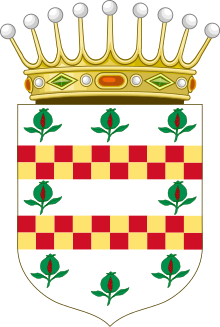Emilio García Gómez
Real Academia Española | |
|---|---|
| In office 22 November 1945 – 31 May 1995 | |
| Preceded by | Antonio Machado[a] |
| Succeeded by | Juan Luis Cebrián |
Emilio García Gómez, 1st Count of Alixares (4 June 1905 – 31 May 1995) was a Spanish Arabist, literary historian and critic, whose talent as a poet enriched his many translations from
Life

Emilio García Gómez decided to pursue Arabic as a career after attending
Recipient of a scholarship to
While living in Granada he had become friends with Manuel de Falla the classical music composer and with Federico García Lorca the poet, both aficionados of Flamenco.[2] Inspired by the translations of Gómez, García Lorca wrote his Diván de Tamarit. Here, the poet was not following in imitation of a traditional Arabic verse but rather paying it contemporary homage, García Gómez favorably observed.[3]
He was again in
Later, he served as the
Throughout his career, Emilio García Gómez was widely admired.[5] He would receive several prestigious academic and literary awards. He lived until he reached the age of ninety.
On 7 October 1994 García Gómez was raised into the
Works
A major focus of his academic work was
His many translations of Arabic poetry were received with acclaim by the literary public, as well as by many
Assisting two of his mentor professors, García Gómez edited shorter, more popular versions (though still rigorous) of the well-known tomes by Julián Ribera y Tarragó[11] and Miguel Asín Palacios[12] Later, he and Prof. Rafael Lapesa produced several articles on their teacher and elder Miguel Asín Palacios.[13]
After returning from his travels to the Middle East in the late 1940s and early 1950s, he published (under the title Los Días) his translation of the Egyptian writer
Though his main academic work was in Arabic poetry, he also approached the social issues involved in understanding the Islamic presence in medieval Spain. García Gómez collaborated with the French historian
In his later years García Gómez labored on the various facets of the literary events surrounding the Alhambra, an architectural gem, site of the government offices and the residence of the Muslim rulers of Granada, where the Islamic presence lingered the longest.
Notes
- ^ Machado was elected for the position in 1927 but never took the seat
Notes
- ^ James T. Monroe, Islam and the Arabs in Spanish Scholarship (Leiden: Brill 1970, Reprint Cambridge: ILEX Editions/Harvard University Press 2021) at 202–203, 206.
- ^ Both de Falla and García Lorca were involved in the Flamenco revival Concurso y Fiesta del Cante Jondo held in Granada in 1922. Cf., Eduardo Molina Fajardo, Manuel de Falla y el "Cante Jondo" (Universidad de Granada 1998).
- ^ García Gómez, "Nota al Divan del Tamarit" {1934} in Silla del Moro y Nuevas Escenas Andaluas (1948, 1954) at 88–92, 92; Monroe, Islam and the Arabs in Spanish Scholarship at 204–206
- ^ The Emilio García Gómez Article at the Spanish Wikipedia site.
- ^ E.g., Ángel Valbuena Prat, Historia de la literatura española (Barcelona, 6th ed., 1960) at vol. 3: 784–786, cited by Monroe at 218; Gerald Brennan, The Literary History of the Spanish People (Cambridge Univ. 1951, 2nd ed. 1953, reprint Meridian 1957) at 21, 454.
- ^ A. J. Arberry, Moorish Poetry (Cambridge 1953) at ix–x.
- Ramon Menendez Pidaltreats of the zejel (related strophic verse and music) in his Poesía árabe y poesía europea [1937] (1941, 1943, 1946) at 9–67.
- ^ Regarding García Lorca's Diván de Tamarit, see "Life" at note 3, here above.
- ^ El collar de la paloma [Dove's Neck Ring] (1952); cf. Monroe, at 212–213.
- ^ Madrid 1948, reprint Buenos Aires 1954; cf., Monroe, Islam and the Arabs in Spanish Scholarship at 209, 218.
- ^ Ribera, La música de las Cantigas (Madrid 1922), edited by García Gómez as La música árabe y su influencia en la española (Madrid 1927, reprinted Madrid, Mayo de Oro, 1985).
- Dantey el Islam (Madrid 1927).
- ^ En el centanario del nacimiento de don Miguel Asín (1969); cf., his in Al Andalus 34: 460–469 (1969).
- ^ Taha Husein, Los Días (Valencia: Castalia 1954).
- ^ Tawfik al-Hakim, Diario de un fiscal rural (Madrid 1955); cited by Monroe at 214.
- Ramon Menéndez Pidal, translated from the original French by Emilio García Gómez.
- ^ Monroe, Islam and the Arabs in Spanish Scholarship at 210–212, 214.
Selected publications
- Un texto árabe occidental de la leyenda de Alejandro (Madrid 1929). Fastenrath Award
- Poemas arábigoandaluces (Madrid 1930): a translation of ISBN 978-0-87286-242-5. Translated into Arabic by Hussein Mones as Ash-Shi'r al-Andalusi (Cairo 2nd ed. 1956).
- Qasidas de Andalucía, puestas en verso castellano (Madrid 1940).
- Cinco poetas musulmanes (Madrid 1945).
- El collar de la poloma, tratado sobre el amor y los amantes de Ibn Hazm de Cordoba (Madrid 1952), prologue by José Ortega y Gasset.
- Poesía arábigoandaluza, breve síntesis histórica (Madrid 1952).
- Silla del moro y nuevas escenas andaluzas (Madrid 1948, reprint Buenos Aires, Espasa-Calpe, 1954).
- Las jarchas romances de la serie árabe en su marco (Madrid 1965).
- Poemas árabes en los muros y fuentes de la Alhambra (Madrid 1985).
- Poesías / Ibn Al-Zaqqāq ; edición y traducción en verso [del árabe] (Madrid 1986).
- Foco de antigua luz sobre la Alhambra (Madrid 1988).
Collaborations
- Una crónica anónima de 'Abd al-Rahman III al-Nasir (Madrid-Granada 1950), co-authored with Évariste Lévi-Provençal.
- En el centario del nacimiento de don Miguel Asín (Madrid: CSIC 1969), with Rafael Lapesa; also in the journal Al Andalus (1969).
